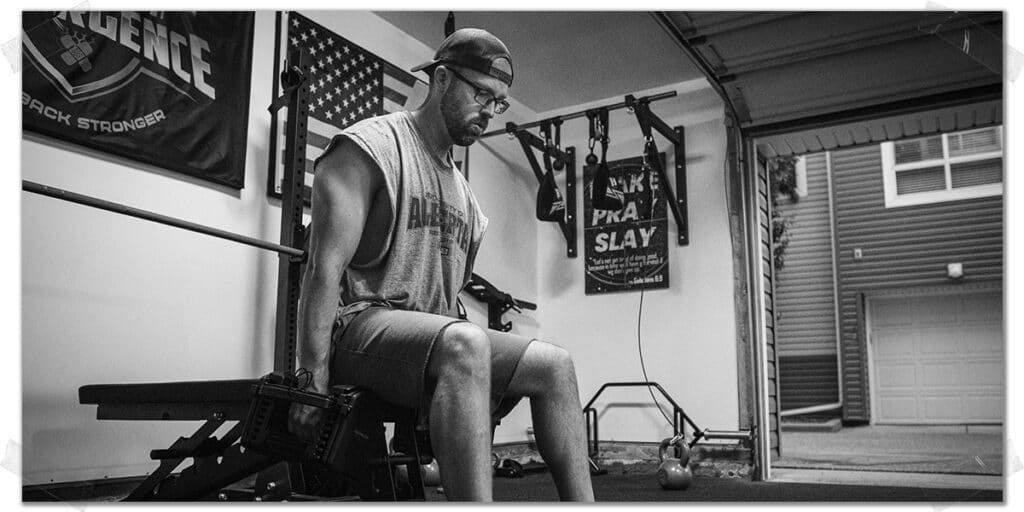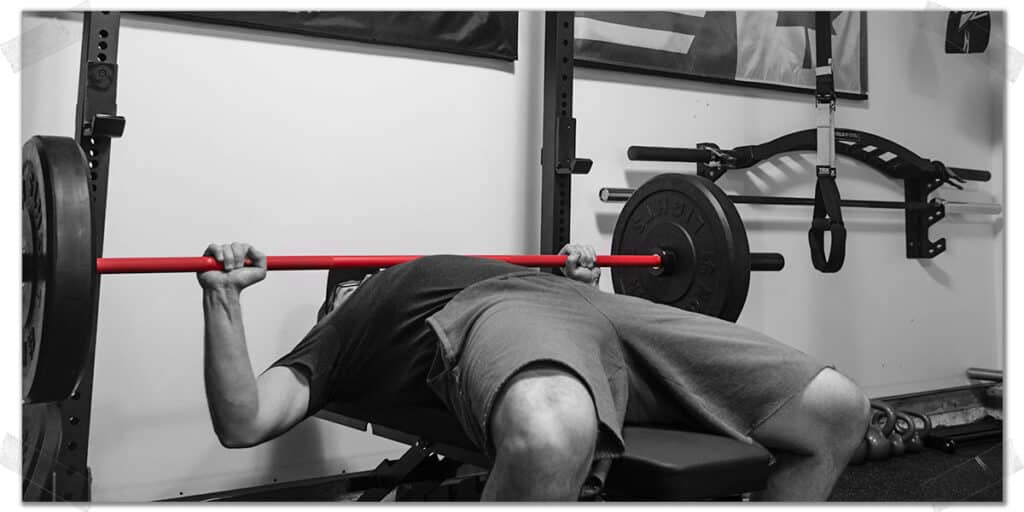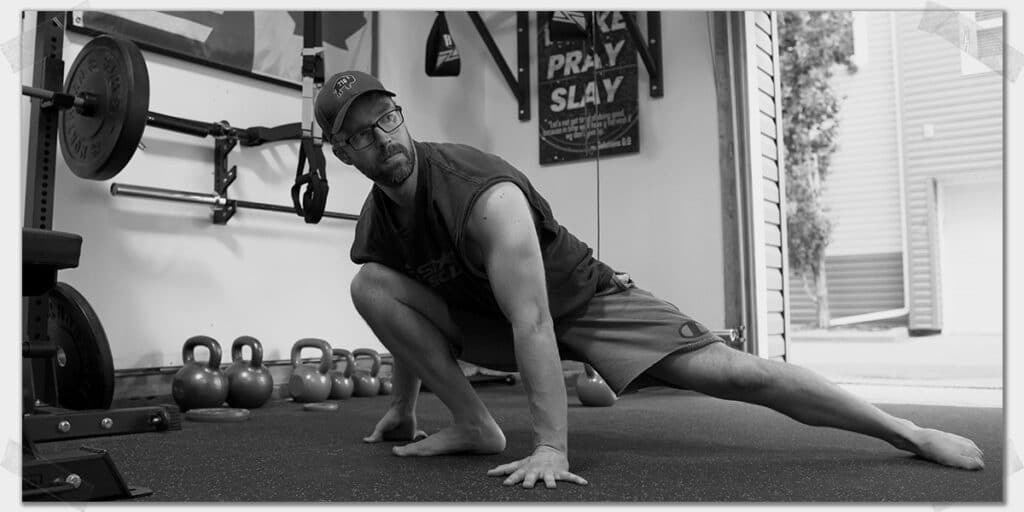Whether in a basement, a garage, or a spare bedroom, it’s not uncommon to hear of people dedicating a small portion of their living quarters to building a home gym or fitness studio. Sure, having access to a fitness area and workout equipment right in your residence has many perks, but does that mean it’s worth it? The answer might not be all that clear-cut.
Building a home gym can have substantial benefits, but it isn’t for everyone. It’s likely best for those serious about their training and know what they want from their pursuits. Limitations such as space, finances, and motivation may be reasons not to build a home gym.
Naturally, there’s a lot more to unpack, so if the preceding paragraph has piqued your interest, you’ll be happy to know that the rest of this article will dissect this issue in greater detail, revealing some rather interesting points along the way. You’ll learn compelling reasons for building a home gym and (perhaps) reasons against doing so.

A small request: If you find this article to be helpful, or you appreciate any of the content on my site, please consider sharing it on social media and with your friends to help spread the word—it’s truly appreciated!
Related content:
Naturally, if your financial resources were infinite, we wouldn’t be asking this question; you could build and own anything you desired, rendering the topic of this article moot. Alas, you, like me, might find the financial aspect or investment as one of your main hesitations for establishing a gym in your basement, garage, spare room, etc.
So, I’ll assume this is the case with you, and as such, the pros and cons listed below will be based on this condition.
Full disclosure: while I love having my own home gym (albeit a humble one), I am setting my bias aside for reasons why having one of your own might not be worth it, as they are indeed valid.
Pros: Reasons why building a home gym is worth it
Being able to pump some iron right in your own living quarters has plenty of advantages. Naturally, you may find some advantages to be better than others since we all have different wants, needs, and training goals.
That being said, the reasons listed below are likely the most universal and compelling ones to commit to building your home gym haven, be it a minimal one or one that takes up your entire household.
Reason 1: You have the space for it

In a perfect world, anyone looking to build a home gym—one they would be proud to call their own—would have enough floor space to move freely about while housing all of their desired equipment within their dedicated space. While this may indeed be what any home gym enthusiast desires, only a few of us truly find ourselves in this situation. Most of us are rather limited with the square footage we can devote to our gym space or exercise area.
This isn’t to say you must devote a significant portion of your living quarters to having it act as your home gym facility, but you will need something.
Depending on the type of workouts and training you’re looking to perform, you may need to devote an entire basement, garage, or spare room to housing your fitness equipment (but likely not, assuming you fall in line with Reason 3, discussed momentarily). If you’re looking to maintain a rather minimal setup, you might be able to get away with a few basic pieces of equipment that don’t take up much space.
Keep in mind: A minimal setup consisting of dumbbells, a barbell, and a workout bench can go a long way for strength training workouts!
Minimal space requirements
Most individuals looking to perform standard strength training-based workouts with a very basic free weight setup and perhaps perform some cardio training (using a piece of equipment like a stationary bike or a treadmill) will need about 150 square feet of space (equivalent to a 10′ x 15′ room or area).
Assuming you have a workout bench, squat rack or squat stands, and cardio equipment such as a treadmill, going any lower than this square footage will likely start to challenge you for space when performing exercises such as lunges, Turkish getups, and others that require enough open floor space.
Nonetheless, if you can find a way to dedicate a small area (or large area) of your living quarters to your strength and fitness pursuits, you’re off to a solid start with why it might be worth it to build a home gym.
Reason 2: You can motivate yourself without a partner
A training partner makes all the difference when it comes to getting the most out of your workout or activity sessions. Even Arnold himself openly stated that his training partner, Franco Colombo, was essential to work out with in order to get the most out of his training.
It is to be assumed that if you’re looking to build a home gym, you’re going to be performing at least a portion of your workouts or training sessions by yourself. There’s no rule saying you can’t have a friend or training partner come over and work out with you, but realistically, assuming you’re training consistently, you’ll be spending a number of workouts training by yourself.
“Ultimately, if you’re interested in strength training-based workouts at home, you’ll need to be a fan of free-weight equipment such as barbells, dumbbells, and kettlebells.”
For some people, this can be a complete deal breaker; working out by themselves is something they simply can’t fathom. It’s understandable, but it also means you’ll likely be better off using that extra space in your residence for something other than workout equipment. There’s no point in owning fitness equipment if you can’t motivate yourself to use it.
Over my years in the health and fitness profession, I’ve found that people who have their own workout space in their living quarters are highly motivated to work out and can, therefore, get by without having a training partner, either at all or for a portion of their workouts.
I will state, however, that, like nearly all other lifters out there, I will never be able to push myself quite as hard when I lift weights and exercise on my own as when I have a friend or training partner with me. I like training by myself much of the time, but I (and likely you, too) need to remember that having a good training partner present will always allow us to push a bit harder than when we’re working out by ourselves.
Reason 3: You know how to use the basics

For the vast majority of home gym enthusiasts, we not only have limited space to contend with, but most of us also have humble budgets to work with as well. As such, we must be selective with the equipment we purchase since we simply can’t afford to purchase every piece of equipment we’d otherwise like.
As a result, we usually try to strike the trifecta of purchasing equipment that is highly versatile, doesn’t take up excessive floor space, and doesn’t break the bank. (I advocate this for pretty much everyone who wants to be financially responsible.)
Taking myself as an example, I have a small 15′ x 20′ garage. If I were to put a squat cage or even half rack in there, I would lose substantial floor space. This isn’t to say it would be wrong of me to do so, but I have instead opted for squat stands. Not only do they take up less space, but I saved a fair number of pennies by going with these instead.
Would I have liked the extra versatility that comes with a full cage? Of course, but I know how to get around those limitations, so I’m just fine without a cage or rack.
Additionally, I’m well-versed in knowing which pieces of equipment are highly versatile and ideal for my training needs. A TRX, as an example, is a basic piece of equipment and one that I know will provide me with an absolute world of opportunity for:
- Numerous upper body strength training exercises
- Numerous lower body strength training exercises
- A variety of mobility-based movements and stretches
Related article: How To Use A TRX For Injury Prevention (Superior Benefits)
Ultimately, if you’re interested in strength training-based workouts at home, you’ll need to be a fan of free-weight equipment such as barbells, dumbbells, and kettlebells. The good news is that these are ultimately all you need to strengthen your entire body.
Sure, a cable tower and larger pieces of equipment such as a glute ham raise or belt squat machine would be nice, but the real estate and cost of bringing equipment like this into your gym space will likely be on the more substantial side and, therefore, might not be viable.
Related content:
Reason 4: You’re always short on time
This reason just might be the biggest motivator for having built a garage gym of my own, though, if I’m honest, it’s probably a tie along with reason 5. Nonetheless, I can’t stress enough how beneficial it is for me to not have to drive across town, park, head into the gym, change, workout, change again, drive home, and get on with my day.
Undoubtedly, over the past few years, I’ve saved dozens of hours (and multiple tanks of gas) by being able to pump iron at home. Not having to hop in my vehicle and drive to the nearest gym facility saves enough time as it is, but in addition to this, I never have to worry about waiting to use a piece of exercise equipment that others are using; I don’t have to ask anyone if I can work in with them, or how much longer they have before they’re done.
Since I have a rather busy daily schedule, I can’t afford to have my workouts derailed by unexpected surprises (bad traffic, a jam-packed gym, etc.) that slow down my workout or force me to change my workout plans altogether.
The commute time from my living room to my garage gym is about fifteen seconds, meaning I don’t have to worry about losing time driving across town, getting stuck in traffic, and having to drive back afterwards.
Even more, a home gym essentially provides 24/7 access to your workouts; it’s always open. If I need to work out at certain hours that don’t coincide with the local gym’s hours, it’s not an issue.
“Since I have a rather busy daily schedule, I can’t afford to have my workouts derailed by unexpected surprises (bad traffic, a jam-packed gym, etc.) that slow down my workout or force me to change my workout plans altogether.”
Reason 5: You’re sick of public gym shenanigans

I’ve worked out in public and private gyms for over twenty years now. I’d swear I’ve seen it all, but knowing how ridiculous public gyms can be, I know I haven’t. I became sick of crowded public gyms long ago. What I DO know is that I am quick to tire of working out around the general public.
To put it mildly, distractions and annoyances are plentiful, and gym etiquette is often lacking. People smell, make obnoxious noises, don’t wipe their sweat off of equipment, claim multiple pieces of equipment for themselves, and so on. The older I get, the less tolerance I have for these things. (Not to mention, I’m typically not a fan of the music that many gyms play within the facility.)
Thankfully, these aren’t issues for me anymore, and when I occasionally do workout out in a public gym, I can tolerate these things since my “tolerance buffer” replenishes in between these infrequent public workouts.
If any of these nuisances or downright abominations strike a chord with you, it may be time to start planning how you’ll work out at home. Even if it’s with a few basic pieces of equipment that reduce the frequency for which you need to workout in a public gym.
To be clear: There are gyms within my hometown that are downright amazing and don’t give me these types of headaches, but I have a substantial drive across town to get to them, which takes me back to Reason 4 regarding home gym ownership.
Reason 6: You have an immune system that needs to be cautious
This was a valid reason I ran into a few years ago when the Covid pandemic was still largely prevalent. Not only did I want to look out for myself, but at the time, I was also living with other family members and needed to look out for their well-being in addition to mine.
Though I didn’t really have any home gym equipment at the time, I knew that getting my hands on the basics would be enough to keep me in shape at home without ever going to public facilities and risk bringing back some bug or virus that could then be picked up by my loved ones.
Cons: Reasons why building a home gym isn’t worth it
Not all that glitters is gold. While having the ability to improve your strength and fitness within the confines of your own home is indeed marvellous in many ways, there are reasons why having a home gym may be more of a drawback than a benefit.
Reason 1: There are viable nearby alternatives
A few years ago when I was house hunting, I came across a lovely little townhome that checked all my boxes and was only a couple of minutes away on foot from an exceptional gym facility.
I told myself that if I were able to close on this townhome (spoiler alert: I wasn’t) that there’d be no need to build a home gym. I’d be willing to put up with an arduous two-whole-minute walk to get to the front door of the facility.
Sure, I’d need to put up with the public again, but I’d be willing to do that since this particular gym wasn’t all that bad and not having to drive across town to attend would increase my patience.
Not to mention, with a large public gym essentially in my backyard, this meant that I’d be able to use the garage at this particular townhome for other things, such as, you know, actually keeping my vehicle within it (what a concept!).
Related article: It’s Worth Overcoming ‘Gymtimidation’ (Here’s Why & How to do it)
If you have access to a nearby gym, it’s probably not worth the hassle of building a gym for yourself. Of course, there could be plenty of exceptions to this, but under an otherwise average set of circumstances, a decent nearby gym will simply have far more equipment and space than you could ever dream of procuring.
So long as you’re ok with putting up with the general public or other lifters and individuals around you, I’d contend that keeping the extra space in your house reserved for something other than your workouts would likely work to your benefit.
If I’m honest, there are times when I wish I had my garage space reserved for performing activities other than working out.
Reason 2: You won’t make back your money on your investment
Devoting an area of your home to working out typically isn’t the cheapest pursuit. For most individuals, acquiring equipment, even if it’s second-hand, tends to involve spending a nice little chunk of change.
Assuming you’re trying to work within a humble budget, one solid way to determine if getting a home gym going is indeed a worthwhile pursuit is to do a few quick calculations. Particularly, I’d advise running through a few financial calculations to see if you’ll save money over the long run.
Some financial numbers you’ll want to first consider would be:
- Cost of an annual gym membership to a nearby facility
- Estimated fuel costs over the span of one year driving to and from the facility
- Estimated cost of time involved with commuting to and from the facility (you’ll want to establish a monetary value for what your time is worth per hour).
Related content:
Next, you’ll want to compare this to the cost of any equipment you may want to purchase for your gym setup. You could do this by calculating the cost of all the equipment you’d like to purchase, but I’d advocate calculating the cost of any purchases over the first year of building your home gym.
Depending on how much equipment you’d like to own, you may be unable to make all these purchases within a year. Maybe this isn’t the case for you, but for most of us (myself included), purchasing equipment over a span of time typically works better for the budget.
The key, therefore, is to compare the annual purchase expenses with those associated with working out at a gym other than your home.
Related article: Getting A Gym Membership: Advantages | Disadvantages | Considerations
Sample calculations
Let’s say an annual gym membership would cost you $600, and your estimated fuel expenses of commuting to and from the facility for that year would be $150. Let’s also say your total annual time lost to that commute would be a total of 6 hours, with that time being valued at $50 dollars per hour.
This simplistic calculation would work out to be a total of $1,050 per year to work out at your local gym ($600 gym membership+$150 fuel expenses+$300 time lost).
If you were to spend $1,500 on home gym equipment for that year as a means to work out at home, you’d have a net loss of $450. Therefore, for this first year, you’d lose a bit of money rather than working out at the nearby gym. If only considering this first year, it’d perhaps make sense to forego building a home gym.
And for some, this is reason enough not to go along with building a gym in their living quarters, which is fair enough.
Reason 3: You won’t be able to perform the type of training you’d like to
Knowing what type of training or exercise you’d like to do at home is essential before purchasing any equipment. And for some, the type of training they want to do simply isn’t overly (or at all) compatible with their current living quarters.
Unfortunately, it may simply be a case of acknowledging that you’ll need to grit your teeth and perform your training elsewhere, even if you don’t want to do so.
Times where this may be the case could include:
- The main aspects of your training involve highly specialized equipment
- You require multiple pieces of equipment that you simply don’t have space for
- Your training relies heavily on movements and activities that require a vast amount of space
- You live above ground level, and your training would involve making too much noise (dropping weights, jumping, etc.)
Generally, these limitations don’t mean that you still can’t perform some aspects of your training at home, but it may simply be a case of you asking yourself if it’s worth it to do so; some people don’t mind splitting up their training in this manner, but others find it isn’t worth it.
Reason 4: You’ll be changing residences in the near future
Building a home gym is one thing. Moving it is another. It might not be all that bad if you have a very minimalist set up with some small pieces of equipment, but if you’re looking at a more elaborate setup (full garage, basement, etc.), and know you’ll be moving to another location in the near future, it may simply be more practical to forego the home gym efforts for now.
You certainly can decide to pack everything up and move it to your new residence, but you’ll need to ensure you have the space for it and some extra hands to help you move it if you aren’t hiring a team of movers to do it for you.
It’s not the most convincing argument against building and owning a home gym, but there are times when this could be an issue for certain folks and, therefore, deserves a mention.
Final Thoughts
Whether you dream of owning a home gym or are simply giving it consideration and weighing your options, there are definitely pros and cons with having a home gym you can call your own. Neither is right or wrong; it (as always) depends on your individual circumstances, factors and desires.
Whichever you choose, just be sure to keep on lifting and to keep lifting often!

Hi! I’m Jim Wittstrom, PT, DPT, CSCS, Pn1.
I am a physical therapist who is passionate about all things pertaining to strength & conditioning, human movement, injury prevention and rehabilitation. I created StrengthResurgence.com in order to help others become stronger and healthier. I also love helping aspiring students and therapists fulfill their dreams of becoming successful in school and within their clinical PT practice. Thanks for checking out my site!

